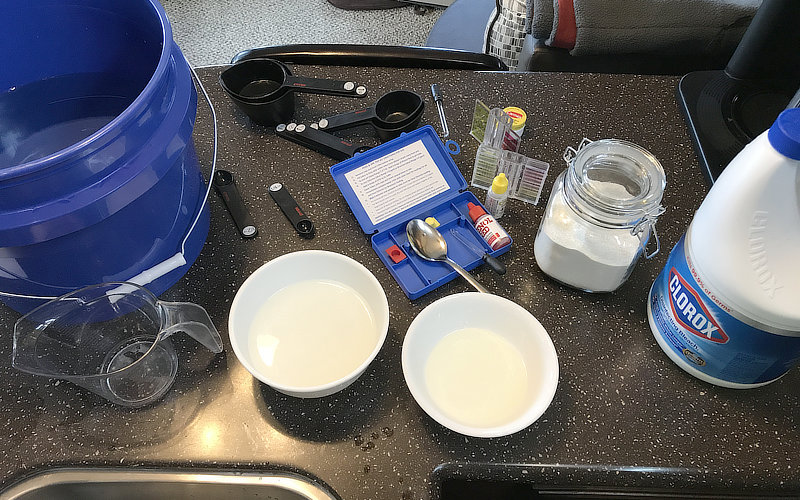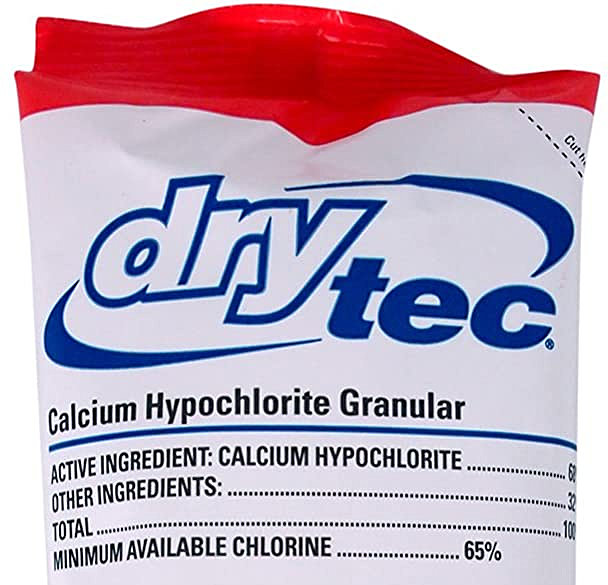How To Make Bleach From Pool Shock – Calcium Hypochlorite

Calcium Hypochlorite (also known as ‘Pool Shock’) is the main active ingredient of commercial products called bleaching powder or chlorine powder. It’s primary uses are for chlorinating / sanitizing swimming pools. This compound is relatively stable and has greater available chlorine than sodium hypochlorite (the active ingredient in Regular Bleach).
The advantage of Calcium Hypochlorite (pool shock) versus regular bleach is its shelf life when stored properly (dry, cool, dark). I’ve read at least 10+ years, as well as indefinite. In either case, it’s a great item for preparedness. Why? because just a single 1 pound bag of ~ 70% Calcium Hypochlorite can treat LOTS of water. Whereas regular bleach has a poor shelf life. Read more below regarding safe storage and how much water you can treat.
I always wanted to experiment and find out for myself — What is the formula to make your own equivalent Regular Bleach solution by using Calcium Hypochlorite (pool shock).
There are a number of results when you search the internet. But I wasn’t going to trust any of them without setting up my own temporary chemistry lab and testing for myself. I wanted to trust but verify. Well, I just did. Here’s what I found…
How Much Pool Shock (Calcium Hypochlorite) To Make Bleach
The following information is presented as a result of my own testing. It is in essence, not intended to be presented as absolute fact. Though I am confident in my own results. Feel free to duplicate the experiment with your own proof-of-concept.
Most of us are familiar with Regular Bleach. And preparedness-minded individuals may know how much Regular Bleach to disinfect water or sanitize surfaces (links below).
So my aim here with this post is to make equivalent Regular Bleach from Calcium Hypochlorite.
The quick answer is this. To make a bleach solution which approximates the strength of regular bleach concentrated at ~ 6% (sodium hypochlorite), use the following formula:
- 3 teaspoons (same as 1 tablespoon) of pool shock (~ 70% Calcium Hypochlorite)
- 1-1/2 cups of water
DO NOT DRINK THIS!
We’re talking about making your own bleach… which you wouldn’t drink, right?
To Make 1 Gallon of Bleach From Calcium Hypochlorite (Pool Shock)
- 11 Tablespoons of ~ 70% Calcium Hypochlorite
- 1 Gallon of water
You might be wondering why the seemingly odd amount of solution for my initial formula (1-1/2 cups). It was the basis for my testing:
It started with a document titled “TB MED 577” from the United States Department of the Army. Sanitary Control and Surveillance of Field Water Supplies. (view hard-copy on amzn)
In it, while referencing tables I-1 and I-2, (page 163 of this PDF), the 1-1/2 cups comes from a note regarding dissolving an amount of (“high-test” ~ 70%) Calcium Hypochlorite in a half canteen cup (1½ cups) of water. Their reference was canteen cups. So that’s where I started…
I began with the data from those two tables and then interpolated the amount of Calcium Hypochlorite necessary for the equivalent amount of Regular Bleach one would use to disinfect water.
[ Read: Bleach – Water Ratio for Drinking Water Purification ]
Long story short, the direct math from their tables worked out be about 2 teaspoons Calcium Hypochlorite per 1-1/2 cups water. However my real world chemistry lab tests revealed that 3 teaspoons of “high test” (~ 70%) Calcium Hypochlorite is closer to matching “regular bleach” with a 6% concentration of sodium hypochlorite.
This also matches with some of what I found while searching the internet in general.
Trust but Verify | How I Tested For Equivalency
First I acquired non-chlorinated water from a nearby source. The water was not muddy, dirty, or turbid. Though it had not been treated in any way.
Using fresh regular bleach (just purchased) with a 6% concentration of sodium hypochlorite… I used an eye-dropper to release 2 drops into a quart (1/4-gallon) of the aforementioned water.
Why? Because typically, 8 drops of said bleach per gallon of water will result in approximately 6 ppm (parts per million) (same as mg/L).
I verified with a chlorine test kit that the resulting ppm was in that range.
NOTE: Though 6 ppm is fairly high when it comes to chlorinated drinking water, if you’re using it to disinfect non-treated sources – the residual level (after the recommended 30 minutes) will drop. The more turbid the water, the more it will drop. Sometimes, a lot! That’s how it works.
After having established a baseline, I mixed up a batch with Calcium Hypochlorte. Firstly, 2 teaspoons with 1-1/2 cups water. I stirred it well, and let sit for several minutes. Then, using an eye-dropper, I deposited 2 drops into one quart of untreated water. I then measured chlorine level with a test kit. It was subjective, but it may have indicated ~ 2 ppm more or less. Certainly not as high as my results with Regular Bleach (though still would have been generally ‘good enough’).
Next batch. 3 teaspoons (same as 1 Tablespoon) of ~ 70% Calcium Hypochlorite with 1-1/2 cups water. Stirred it up. Then released 2 drops into another fresh batch of untreated water. Tested with chlorine test kit. The results were pretty similar to Regular Bleach. Being critical, the results were still appearing a little lower than Regular Bleach, but it’s subjective (lighting conditions and all).
So my final answer — How to make regular bleach equivalent by using calcium hypochlorite is any of the following:
1 Tablespoon per 1-1/2 cups water
2 teaspoons per cup of water
11 Tablespoons per gallon of water.
DO NOT DRINK THIS!
THIS IS EQUIVALENT TO REGULAR BLEACH.
Now That You’ve Made Your Own Bleach…
Bleach has a shelf life. My general advice is it may lose half it’s strength within a year. Your results may vary. So make what you need. You might save a few bleach jugs for use with making your own bleach from Calcium Hypochlorite.
Disinfect Water for Drinking
Make Your Own Disinfectant (NOT FOR DRINKING)
The amount of bleach you use is VERY DIFFERENT for drinking water versus disinfecting surfaces!
Refer to the following articles for more details:
[ Read: Bleach – Water Ratio for Drinking Water Purification ]
[ Read: Disinfectant Bleach – Water Ratio for Surfaces ]
How Many Gallons of Bleach From 1 Pound Bag of Pool Shock?
Using my digital scale, I measured 3 teaspoons of pool shock = 0.45 ounces (which makes 1-1/2 cups bleach equivalent).
So, a 1 pound bag is 16 ounces. That’s 16/0.45 = 35.5
35.5 x 1-1/2 cups = 53 cups = 3.3 gallons
How Much Water Will 1 Pound of Pool Shock Treat?
1 gallon of Regular Bleach can treat LOTS of water. It depends on the concentration used, the turbidity of the water, the organics within the water, etc. However if you use the formula of 8 drops per gallon – and if you do all the math – you end up with about 30,000 gallons of treated water from one pound of pool shock. Even if you halve that amount – factoring for more turbid water – you’re looking at treating ~ 15,000 gallons of water for drinking.
10K-plus (a good rule of thumb) per pound of pool shock (Calcium Hypochlorite).
Safe Storage of Pool Shock (Calcium Hypochlorite)
It’s corrosive. I recommend for long term storage, using glass. Canning jars? Vacuum Seal it? Other? Just saying… if you don’t store properly, it’s going to create a rust problem with all metals where it’s stored. So be careful.
68% Calcium Hypochlorite
(DryTec on amzn)

SAFETY with Chlorine
NEVER add water to the shock (Calcium Hypochlorite). ALWAYS add shock to the water. Chlorine gas can be debilitating in concentrations.
Use in well ventilated space.
